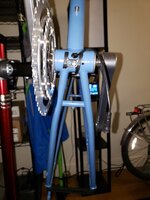indianajo
Well-Known Member
What nobody mentioned here is that with GMAC or a DD hub motor, you use electricity all the time or drag the motor with your feet. My DD hub motor dragged like being in 2 higher sprockets (of 8) than I really was. I ride the bike unpowered 80% of the time, using electricity mostly for days like yesterday with a 20 mph headwind gusting to 33 mph. 30 miles of that wind unpowered is 6 hours. My commute doesn't shorten because the headwind is bad. I do intend concert/festival trips where I pedal unpowered out 50 miles and motor back at midnight. As soon as I find a seat I can sit on for 5 hours.
DD 1000 W motor was much slower accelerating across intersections. That is something I use the geared hub motor for even on windless days, as most traffic lights will not turn green for a bicycle. If they do turn green they turn yellow in 6 seconds unless I went 40' out of my way to push the pedestrian cross button. I use throttle for crossing in gaps in traffic in minimum time. DD motor also used a third more watthours on my hilly commute than the ebikeling 48 v 1300 w motor. Both would red light & drop power on the last hills of the 27 miles with a 17.5 AH battery. The Mac12t I'm using now uses about a fourth less than that. 52-48 v in 30 miles with >80 hills. The plastic gear in the ebikeling motor wore out in ~4500 miles. It was rideable unpowered even with the gear locked up because of the one way clutch. I rode it locked up 7 miles out to summer camp then 27 miles home for replacement without drag. The Mac12t will go about 23 mph on the flat, fast enough without a suspension on a cargo bike. I carry up to 80 lb cargo with it on up to 15% grades. I peak at 35 mph frequently on the downhills before blasting up the next at 10.
Advantage of a conversion, generic battery can be replaced by something even cheaper as the generic prices go down. Mount is a box of aluminum angle & plastic foam, can be customized to fit whatever shape is on sale. The 20 screws has baffled at least two wannabe thieves. Elastic stop nuts you torque every turn of 20 to 40.
DD 1000 W motor was much slower accelerating across intersections. That is something I use the geared hub motor for even on windless days, as most traffic lights will not turn green for a bicycle. If they do turn green they turn yellow in 6 seconds unless I went 40' out of my way to push the pedestrian cross button. I use throttle for crossing in gaps in traffic in minimum time. DD motor also used a third more watthours on my hilly commute than the ebikeling 48 v 1300 w motor. Both would red light & drop power on the last hills of the 27 miles with a 17.5 AH battery. The Mac12t I'm using now uses about a fourth less than that. 52-48 v in 30 miles with >80 hills. The plastic gear in the ebikeling motor wore out in ~4500 miles. It was rideable unpowered even with the gear locked up because of the one way clutch. I rode it locked up 7 miles out to summer camp then 27 miles home for replacement without drag. The Mac12t will go about 23 mph on the flat, fast enough without a suspension on a cargo bike. I carry up to 80 lb cargo with it on up to 15% grades. I peak at 35 mph frequently on the downhills before blasting up the next at 10.
Advantage of a conversion, generic battery can be replaced by something even cheaper as the generic prices go down. Mount is a box of aluminum angle & plastic foam, can be customized to fit whatever shape is on sale. The 20 screws has baffled at least two wannabe thieves. Elastic stop nuts you torque every turn of 20 to 40.
Last edited:
